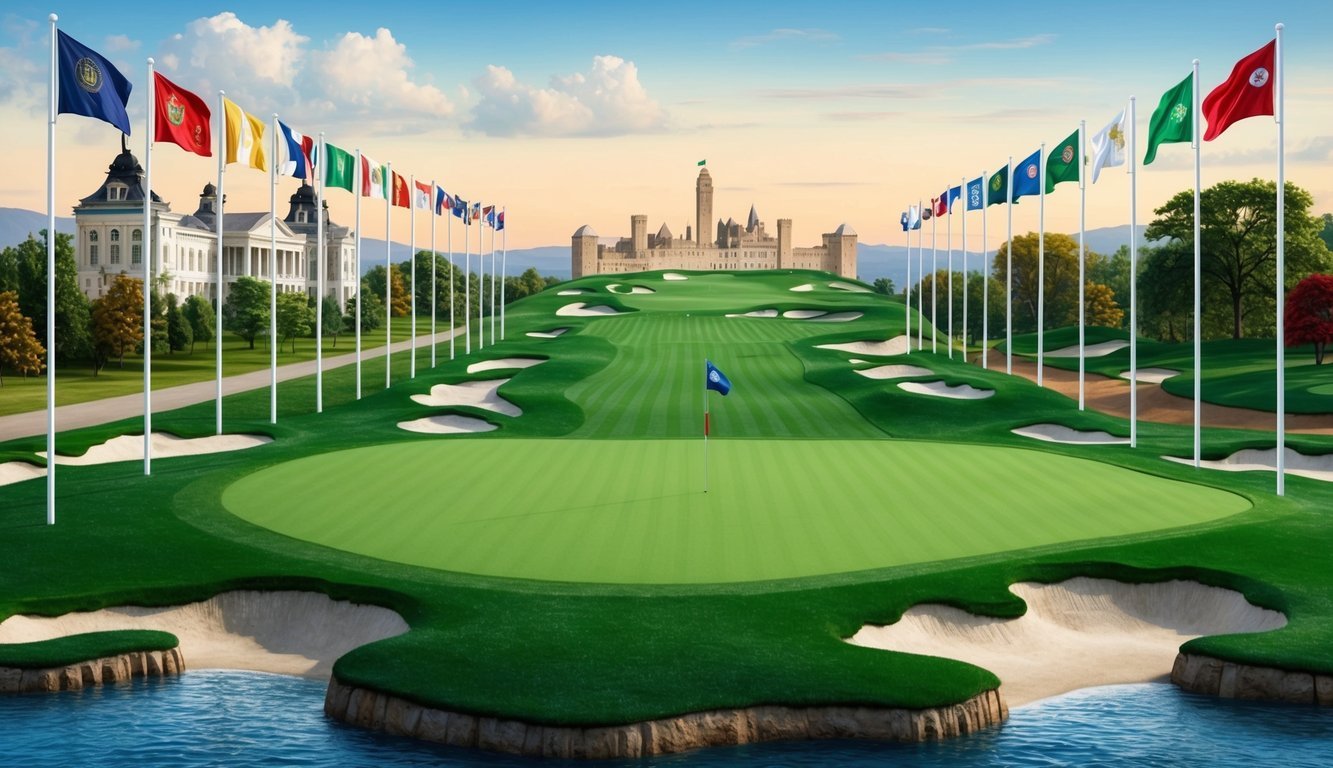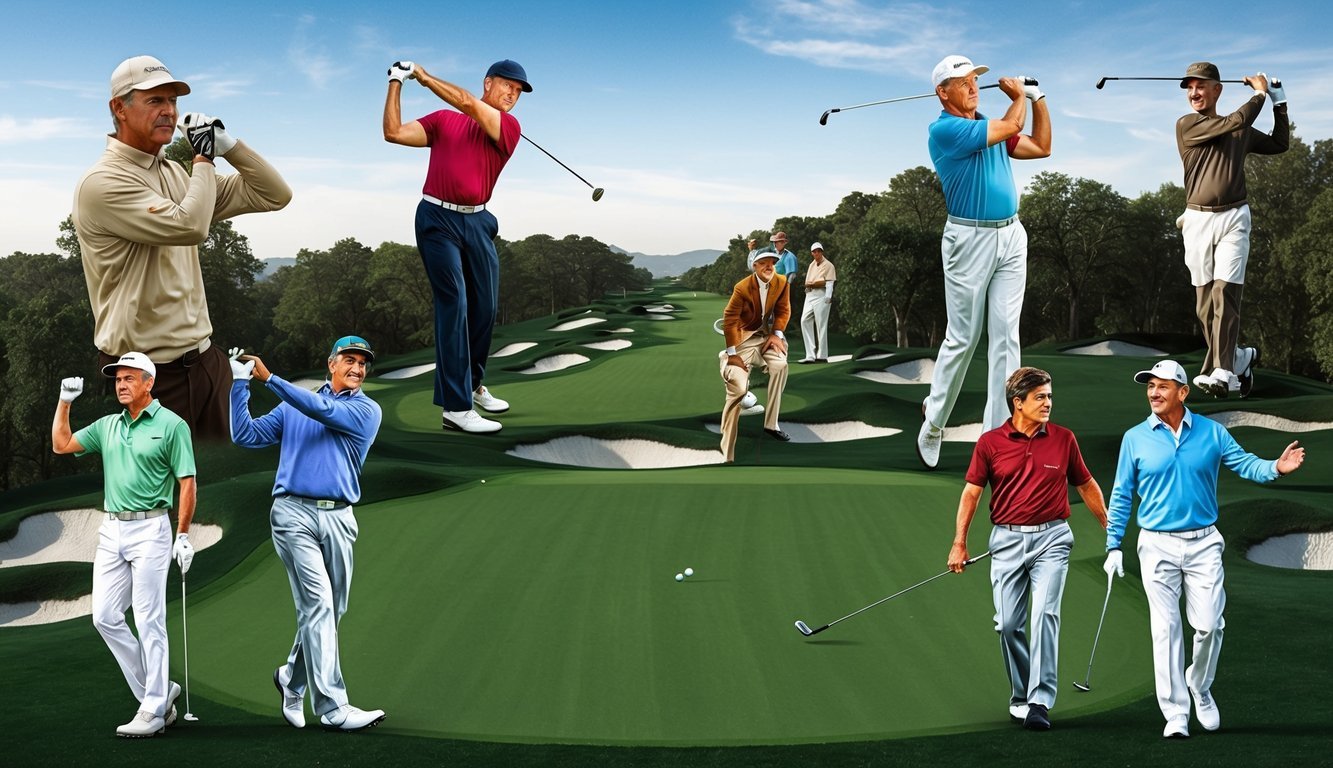Golf has captivated enthusiasts for centuries, transforming from a simple pastime on the windswept terrains of 15th century Scotland to a globally loved sport. Golf originated in Scotland, where it evolved from basic beginnings into a sophisticated game complete with standardized rules and global appeal. Its early versions were played on natural landscapes, setting the stage for what would become modern golf.

Through the years, both equipment and courses have significantly shaped the way golf is played.
Golf balls and clubs progressed from rudimentary materials like wood and leather to the advanced designs you see today.
Iconic courses worldwide have also left a lasting legacy, influencing the sport’s competitive structure and prestige.
Interest spikes globally with major championships, which have spotlighted legendary players and unforgettable moments.
As these tournaments continue to grow, so does the sport’s popularity, drawing in both seasoned players and newcomers alike.
Key Takeaways
- Golf started in 15th century Scotland.
- Equipment has evolved drastically over time.
- Major events boost golf’s global popularity.
Origins and Early History
In exploring the beginnings of golf, you’ll find its roots intertwined with medieval games that involved sticks and balls.
These early versions eventually evolved, gaining distinctive features that led to the sport we recognize today.
Ancient Roots and Royal Ban
Golf’s origins are often linked to the Middle Ages in Scotland.
It evolved from earlier stick and ball games, such as chuiwan in China and kolf or colf, which was played in the Netherlands.
These games involved hitting a ball with a club-like object, providing a foundation for what would become golf.
The game garnered enough attention that even King James II of Scotland noticed.
His interest, however, led to a ban in 1457 because people were playing golf instead of practicing archery.
This royal edict highlights golf’s growing popularity and its perceived interference with more traditional pursuits.
The Spread Throughout Europe
From its Scottish origins, golf began to spread throughout Europe.
During medieval times, people from various European nations engaged in similar games.
The Netherlands, in particular, played a role with colf, which bears striking similarities to modern golf, using long clubs and aiming for targets over long distances.
This spread was gradual, relying on cultural exchanges that occurred through trade and movement across European borders.
The game underwent transformations, adapting to local traditions and landscapes, which helped pave the way for golf’s evolution into the sport cherished by enthusiasts across the continent today.
Each region added unique elements, eventually leading to the standardized form of golf we enjoy now.
The Evolution of Golf Equipment
Golf equipment has come a long way from its humble beginnings.
Over the years, both golf balls and clubs have undergone significant transformations, which have enhanced gameplay and performance.
From Wooden Balls to Modern Golf Balls
In the early days of golf, players used wooden balls.
These were replaced by feathered balls, known as “featheries,” made by stuffing feathers into leather pouches.
This design allowed for more control and distance.
The next major innovation came with the gutta-percha ball, invented in the mid-19th century.
This ball was more durable and easier to produce than its predecessors.
Today’s golf balls are technologically advanced, featuring multiple layers and constructed from synthetic materials.
The core, mantle, and cover each play a role in optimizing distance and spin control.
Modern balls cling to the tradition of constant evolution, making it a crucial aspect of your golf experience.
The Development of Golf Clubs
Early golf clubs were made from wood, specifically hardwoods like hickory.
Over time, the shafts evolved to include steel, which provided greater durability and precision.
The introduction of graphite shafts in the 1970s brought further advancements, offering lightweight options with improved performance.
Today, golf clubs are crafted from a combination of metals and composites, with club heads designed using computer-aided technology for optimal weight distribution and aerodynamics.
Clubs are categorized into drivers, irons, wedges, and putters, each with unique features to support various aspects of your game.
These advancements offer enhanced control and accuracy, ensuring that your tools complement your skills on the course.
Iconic Golf Courses and Their Influence

Iconic golf courses have played a significant role in shaping the sport’s development and culture.
These courses and their architects not only cultivated groundbreaking designs but also influenced the way golf is played and appreciated across the globe.
The Birth of St. Andrews
When you think about legendary golf courses, St. Andrews is often the first that comes to mind.
Situated near Edinburgh, the St. Andrews Links is regarded as the “Home of Golf.”
Dating back to the 15th century, its establishment marked a pivotal moment in the history of the sport.
The Old Course at St. Andrews is renowned for its unique design, featuring strategically placed bunkers and the famous double greens that challenge even the most seasoned players.
The influence of the Royal and Ancient Golf Club of St. Andrews, founded in 1754, has been monumental in shaping golf’s rules and structure.
This iconic location continues to host major golf tournaments, ensuring its legacy endures.
Notable Golf Course Architects
Golf course architects have made substantial contributions to the evolution of golf course design, blending natural landscapes with strategic elements.
Some of the most notable architects include Charles Blair Macdonald and Alister MacKenzie.
Macdonald, known as the “Father of American Golf Architecture,” brought his experience from St. Andrews to the United States.
He introduced innovative designs that set the standard for American golf courses.
Alister MacKenzie, another influential figure, designed famous courses such as Augusta National.
His designs emphasize the integration of natural landscape features into strategic playing conditions.
These architects have left a lasting impact on how courses are constructed, pushing the boundaries of design and enhancing the gameplay experience.
Major Championships and Growth

In this section, you’ll explore the significant role of major championships in shaping professional golf, as well as the impact of international tournaments on the sport’s growth and popularity.
The Four Majors
The men’s golf scene is dominated by four prestigious tournaments known as the majors.
These consist of the Masters, the U.S. Open, the Open Championship (often called the British Open), and the PGA Championship.
Each major offers unique features and challenges.
- The Masters, hosted in Augusta, is famous for its iconic green jacket and beautiful azalea-lined fairways.
- The U.S. Open places a premium on precision and endurance, often set on challenging courses supervised by the United States Golf Association (USGA).
- The Open Championship, coordinated by the R&A, offers golfers the opportunity to vie for the Claret Jug on storied links courses.
- The PGA Championship encourages skilled professionals, making it a critical season highlight.
Achieving victory in all four majors during a career is referred to as winning the Grand Slam, a testament to a golfer’s excellence and versatility.
International Competitions
Golf has flourished around the world, thanks in part to international competitions.
The Ryder Cup is a highly anticipated event, pitting top golfers from Europe against their counterparts from the United States.
This biennial event electrifies fans and sparks friendly rivalries.
Similarly, the Curtis Cup, the women’s equivalent, encourages youthful talent and camaraderie across the Atlantic.
These competitions serve as opportunities for golfers to showcase their skills on a global stage, nurturing the spirit of sportsmanship.
The blend of individual prestige and team dynamics has been pivotal in expanding golf’s appeal worldwide.
Influential Players and Moments in History

Some golfers have left indelible marks on the history of the sport.
Their outstanding skills and unforgettable moments have shaped golf as we know it today.
These legendary figures and pivotal events offer a fascinating glimpse into golf’s rich and evolving story.
Legends of the Green
In the landscape of golf, few names spark as much admiration as Jack Nicklaus, known as the “Golden Bear.” With a remarkable 18 major championships, Nicklaus’s influence is unrivaled.
His sportsmanship and skill continue to inspire many aspiring golfers.
Meanwhile, Tiger Woods ushered in a new era with his intensity and success, becoming a pivotal figure in modern golf.
Arnold Palmer, with his charismatic presence, made significant strides in popularizing golf in America.
Palmer’s rivalry with Nicklaus added excitement to the sport in the 20th century.
Bobby Jones and Ben Hogan are also remembered for their extraordinary contributions to the game.
Each player brought something unique to the greens, enhancing the game’s appeal and accessibility.
Historic Tournaments and Rivalries
Tournaments that have captivated audiences and defined the sport’s legacy fill golf’s history.
The Masters, an annual spectacle, has seen numerous unforgettable moments.
For example, Nicklaus’s 1986 victory at age 46.
The Miracle at Medinah, in the 2012 Ryder Cup, is celebrated for its dramatic comeback.
Rivalries have fueled the competitive spirit of golf.
Nicklaus versus Palmer in the 1960s stands out, offering fans thrilling displays of skill.
These legendary confrontations not only enhanced the players’ careers but also enriched American golf history.
They left lasting memories and set high standards for future golfers.

